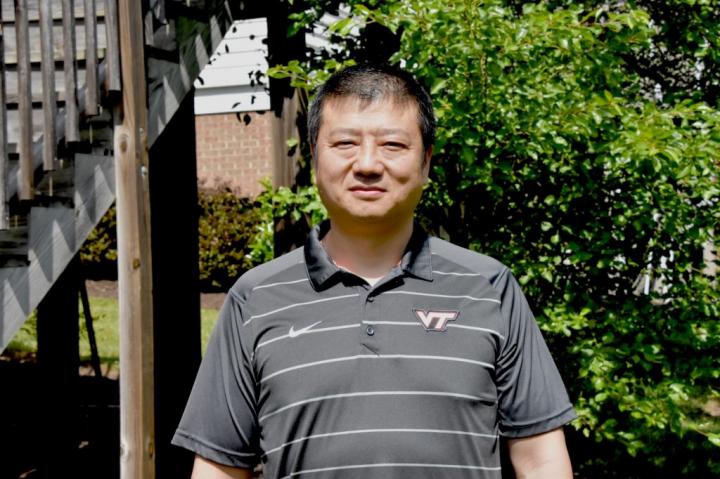
Credit: Virginia Tech
For most people, a coffee stain may go unnoticed, an everyday accident. In the world of physics, though, learning more about why that splotch of coffee dried a certain way could hold the answers to discoveries that improve everything from the paint on new cars to nano-scale drug delivery.
A coffee ring stain occurs because of different ways that liquid evaporates across the wet area. As liquid evaporates more quickly from the outer ring of the spill, liquid molecules from the interior of the spill rush toward the edge to replace what has evaporated, bringing the particles dissolved in the spill to the outer edge.
Drying a solution with solutes dispersed throughout it has become a typical way of creating either new or better materials, but physicists are convinced that there is much to be gained from better understanding how soft matter solutions dry, including solutions of colloidal particles, polymers, and their mixtures. Many such solutions, for example, ink and paint, can be found in your home. Even blood, a cup of hot chocolate, or a respiratory droplet containing virus particles can be regarded as a colloidal solution.
This spring, Shengfeng Cheng, an assistant professor in the Department of Physics, in the College of Science, was awarded a National Science Foundation CAREER Award for research in “Nonequilibrium Physics in Drying Soft Matter Solutions.” A CAREER award is one of the NSF’s most prestigious awards of early-career faculty who have potential to serve as academic role models in research and education and to lead advances in the mission of their organization. Cheng has been awarded $514,786 for 5 years in pursuit of better understanding of drying soft matter solutions.
Physicists such as Cheng aim to control the movement and distribution of substances dissolved into a solvent as a solution is dried.
“Understanding the drying behavior of solute-laden droplets may lead to new methods of fabricating particulate materials, such as a thin film coating a solid surface or drug-loaded particles with the desired distribution of materials,” Cheng said.
If it all seems abstract, Cheng said, consider how an automobile factory paints a new car on the assembly line: Cathodic e-coating (a pre-primer), the primer, basecoat, clearcoat – and sealing, sanding, drying, and oven-baking it at least three times between stages. There are as many as 20 steps involved in getting a vibrant coat of paint on a new car.
“The question is,” he said, “can we mix things in a solvent in the first place and spray it onto a car, and then get stratified layers after one drying process? This is a more efficient way of coating a surface.”
If drying conditions of soft matter solutions can be controlled, Cheng said, physicists hope to make material production and application as a “one-pot process: mixing stuff, put it in a solvent, dry it in a controlled way, and you have it.”
With this CAREER award, Cheng said he wants to understand the key physics underlying the drying process of a solution of particles, polymers, or their mixtures. The most important component is that various gradients emerge during drying. That is, physical properties of the solution become nonuniform when it dries. For a coffee spill, it is the evaporation rate. But other properties, such as temperature and concentration, can also develop nonuniformity. Interestingly, various solutes present in a solution might respond to these gradients in different ways. By fine-tuning the drying conditions, Cheng hopes he may be able to control the gradients and therefore manipulate how the polymers and particles are spread throughout the final product, dry films.
“We perform all these experiments on a computer, which gives us full control and enables us to test a wide range of possible scenarios,” Cheng said.
While making the process of painting new cars more efficient may be a nice-to-have achievement, other applications involving drying soft matter solutions could solve critical world issues.
These include other surfaces that would benefit from a multi-layer coating, in which one layer is mechanically strong and other is chemically useful, such as antibacterial coatings on medical devices and tools.
And solar energy efficiency could be greatly enhanced with better light-absorbing coatings on photovoltaics, Cheng said, the modules that convert light into electricity. A good understanding of drying, as mundane as it sounds, may help make better coatings.
The research may even become more relevant as the world is trying to cope with the coronavirus pandemic. Respiratory droplets are also a soft matter solution. A better understanding of how respiratory droplets dry would help inform policy makers about the best practices to mitigate the virus’ spread.
“Of course, it is hard for me to claim that we will solve all these problems,” Cheng said, “but I believe our work may shed light on better understanding of the drying behavior of solute-laden droplets and lead to new methods that can improve these issues.”
###
Media Contact
Lon Wagner
[email protected]
Original Source
https:/




